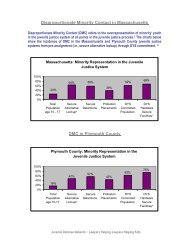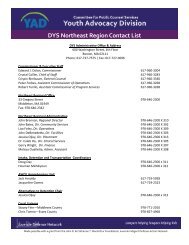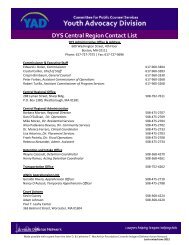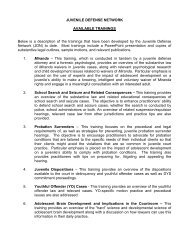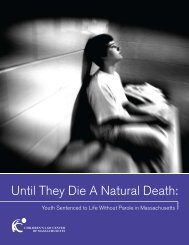States rethink 'adult time for adult crime' - the Youth Advocacy Division
States rethink 'adult time for adult crime' - the Youth Advocacy Division
States rethink 'adult time for adult crime' - the Youth Advocacy Division
Create successful ePaper yourself
Turn your PDF publications into a flip-book with our unique Google optimized e-Paper software.
New York Times<br />
March 11, 2007<br />
The Brain on <strong>the</strong> Stand<br />
By JEFFREY ROSEN<br />
I. Mr. Weinstein’s Cyst When historians of <strong>the</strong> future try to identify <strong>the</strong> moment<br />
that neuroscience began to trans<strong>for</strong>m <strong>the</strong> American legal system, <strong>the</strong>y may point<br />
to a little-noticed case from <strong>the</strong> early 1990s. The case involved Herbert<br />
Weinstein, a 65-year-old ad executive who was charged with strangling his wife,<br />
Barbara, to death and <strong>the</strong>n, in an ef<strong>for</strong>t to make <strong>the</strong> murder look like a suicide,<br />
throwing her body out <strong>the</strong> window of <strong>the</strong>ir 12th-floor apartment on East 72nd<br />
Street in Manhattan. Be<strong>for</strong>e <strong>the</strong> trial began, Weinstein’s lawyer suggested that his<br />
client should not be held responsible <strong>for</strong> his actions because of a mental defect —<br />
namely, an abnormal cyst nestled in his arachnoid membrane, which surrounds<br />
<strong>the</strong> brain like a spider web.<br />
The implications of <strong>the</strong> claim were considerable. American law holds people<br />
criminally responsible unless <strong>the</strong>y act under duress (with a gun pointed at <strong>the</strong><br />
head, <strong>for</strong> example) or if <strong>the</strong>y suffer from a serious defect in rationality — like not<br />
being able to tell right from wrong. But if you suffer from such a serious defect,<br />
<strong>the</strong> law generally doesn’t care why — whe<strong>the</strong>r it’s an unhappy childhood or an<br />
arachnoid cyst or both. To suggest that criminals could be excused because <strong>the</strong>ir<br />
brains made <strong>the</strong>m do it seems to imply that anyone whose brain isn’t functioning<br />
properly could be absolved of responsibility. But should judges and juries really<br />
be in <strong>the</strong> business of defining <strong>the</strong> normal or properly working brain And since all<br />
behavior is caused by our brains, wouldn’t this mean all behavior could<br />
potentially be excused<br />
The prosecution at first tried to argue that evidence of Weinstein’s arachnoid cyst<br />
shouldn’t be admitted in court. One of <strong>the</strong> government’s witnesses, a <strong>for</strong>ensic<br />
psychologist named Daniel Martell, testified that brain-scanning technologies<br />
were new and untested, and <strong>the</strong>ir implications weren’t yet widely accepted by <strong>the</strong><br />
scientific community. Ultimately, on Oct. 8, 1992, Judge Richard Carru<strong>the</strong>rs<br />
issued a Solomonic ruling: Weinstein’s lawyers could tell <strong>the</strong> jury that brain scans<br />
had identified an arachnoid cyst, but <strong>the</strong>y couldn’t tell jurors that arachnoid cysts<br />
were associated with violence. Even so, <strong>the</strong> prosecution team seemed to fear that





